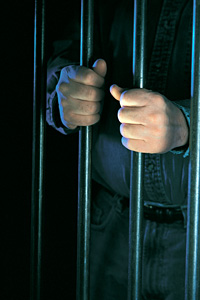While a colleague and I were enjoying a meal together, we discussed some of the current challenges facing the chiropractic profession. An observation he made completely changed the direction of our conversation: "Today's chiropractors were born on third base, and somehow think they hit a triple."
Yet the challenges we face today pale compared to those that confronted chiropractors who went before us. As we approach a new year, it is fitting to remember those courageous chiropractors who went to jail rather than abandon their principles, goals and moral values.
The first chiropractor to be incarcerated for practicing medicine without a license was the founder himself, D.D. Palmer. A 1906 newspaper article chronicles an interview with D.D. at the Scott County Jail, where he was confined in an 8x11 foot cell. The court offered him the alternative of paying a fine; D.D. chose jail, stating, "After I went to jail, several parties phoned to my home and others called offering to lend me money with which to pay my fine. I am not in cell for lack of principal but for an abundance of principle."
 The resolve of the discoverer becomes clear when the interviewer writes, "Dr. Palmer states he is treated well by all the jail officials and has no complaint to make. 'Only one thing I would like to do which they will not allow me,' stated the doctor, 'that is to hang out my sign over the window to my cell … As long as my wife and son [stand] by me, I will be patient and remain contented.'"1
The resolve of the discoverer becomes clear when the interviewer writes, "Dr. Palmer states he is treated well by all the jail officials and has no complaint to make. 'Only one thing I would like to do which they will not allow me,' stated the doctor, 'that is to hang out my sign over the window to my cell … As long as my wife and son [stand] by me, I will be patient and remain contented.'"1
Other early chiropractors did not fare as well while serving time, and the sentences were sometimes harsh. Callender noted: "In 1923, B.F. Lear and W.E. Quartier were fined $500 or 833 days in jail, the maximum sentence for a first offense. They chose the Trumbull county jail in Warren, Ohio."2 If you do the math, that's more than two years.
Jail life could be severe. Another chiropractor, W.D. Adrian, was sentenced to 500 days. A portion of a letter from Morgan County Jail reads, "We see an occasional rat, but all the bugs apparently were killed last summer in a big raid on the jail. I could stand some springs or a mattress on the bars I sleep on, but outside of this and the disagreeable dispositions of some of the prisoners, I am getting along nicely."3
The 1923 Palmer Lyceum was dedicated to those who served jail time for chiropractic. Callender quotes Mac Searby: "It takes a real man, a real woman to go to jail. Some are parted from their families; little baby fingers and arms and lips are far away when bedtime comes. Mother is worrying. Sunshine is nowhere behind the bars except in the hearts of these boys and girls, and the least of their worries is that their business is all shot to pieces. They have cut themselves off from every tie, every support that the free man has, and they have gone back to the cells again when the test came a second time."2
It is not always easy to behave heroically. It is far easier to blend in with the status quo; to not rock the boat, than to trade short‑term expediency for a greater vision. Herbert Ross Reaver, DC, recognized by some as the profession's most jailed chiropractor, wrote, "It was a matter of principle for all of us. We don't practice medicine in any shape or form. To be designated as limited medical practitioners was something intolerable to us. And, of course, it was a useless thing anyway because the so‑called permit limited the types of cases we could handle. It was just something that any chiropractor with any guts could not accept."4
Some paid the ultimate price. Consider the following obituary: "Dr. Albert Ivnik, chiropractor, Cleveland, Ohio, died yesterday at seven P.M. He never recovered from the effects of the exposure at Warrensville Workhouse, and has been in bed from time to time since resuming his practice in February, and finally passed away last night."5
Keating noted that according to Turner, "by 1931 it was estimated the DCs had collectively undergone 15,000 prosecutions (Turner 1931), although there were probably no more than 12,000 chiropractors in practice in that era."6 Arrests continued until 1974, when Louisiana became the 50th state to license chiropractors.7
In accepting the 2004 Lee‑Homewood Award, Russell Gibbons said, "The right to health‑care freedom somehow took its place along with those movements that had characterized the story of progressive reform in America. Jailing of chiropractors and the struggle that this represented would become part of the process of building a better nation by the abolitionists, the suffragettes, the labor movement, the civil rights struggle – all of which would have a larger meaning and understanding after that simple act of defiance outside a county jail."8
Consider what impact one courageous person can accomplish. When Rosa Parks refused to give up her seat to a white man on a bus in 1955, she changed the course of history. How easy it would have been for her to "fit in" and accept things as they'd been done in the past, regardless of how insulting, and without consideration for the future.
Thankfully, we are not asked to give our lives for chiropractic. As guardians of our "sacred trust," we are, however, expected to act heroically in practicing, teaching, and defending the profession, and those it serves.
References
- Keating JC Jr. "D.D. Palmer's Lifeline." National Institute of Chiropractic Research. Quoted material originally in the Davenport Democrat and Leader, 1906.
- Callender A. "Buckeye Chiropractic: Turbulence in a Limited Branch of Medicine, 1915‑1975." Chiropractic History, 1995;15(2):79‑89.
- Originally in Fountain Head News, 1923;13(7):6. Quoted in Callender (reference 2).
- Bower N, Hynes R Jr. "Going to Jail for Chiropractic: A Career's Defining Moment." Chiropractic History, 2004;24(2):21‑26.
- Originally in Fountain Head News, 1923;12(46):1. Quoted in Callender (reference 2).
- Keating JC Jr, Cleveland CS III, Menke M. Chiropractic History: a Primer. Association for the History of Chiropractic; Davenport, IA, 2004.
- "Louisiana: The Final Struggle for Licensure." Digest of Chiropractic Economics.
- Gibbons RW. "Acceptance of the Lee‑Homewood Award: Remarks, 22 May 2004." Chiropractic History, 2004;24(2):17‑18.
Click here for previous articles by Christopher Kent, DC, Esq..





